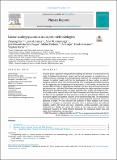Por favor, use este identificador para citar o enlazar a este item:
http://hdl.handle.net/10261/265291COMPARTIR / EXPORTAR:
 SHARE
BASE SHARE
BASE
|
|
| Visualizar otros formatos: MARC | Dublin Core | RDF | ORE | MODS | METS | DIDL | DATACITE | |

| Título: | Linear scaling quantum transport methodologies |
Autor: | Fan, Zheyong; Garcia, Jose H. CSIC ORCID; Cummings, Aron W. CSIC ORCID; Barrios Vargas, José Eduardo CSIC ORCID; Panhans, Michel; Harju, Ari; Ortmann, F. CSIC ORCID; Roche, Stephan CSIC ORCID | Palabras clave: | Quantum transport 2D materials Numerical methods Topological materials Kernel polynomials method Time-dependent Schrödinger equation |
Fecha de publicación: | 7-abr-2021 | Editor: | Elsevier | Citación: | Physics Reports 903: 1-69 (2021) | Resumen: | In recent years, predictive computational modeling has become a cornerstone for the study of fundamental electronic, optical, and thermal properties in complex forms of condensed matter, including Dirac and topological materials. The simulation of quantum transport in realistic models calls for the development of linear scaling, or order-N, numerical methods, which then become enabling tools for guiding experimental research and for supporting the interpretation of measurements. In this review, we describe and compare different order-N computational methods that have been developed during the past twenty years, and which have been used extensively to explore quantum transport phenomena in disordered media. We place particular focus on the zero-frequency electrical conductivities derived within the Kubo–Greenwood and Kubo–Streda formalisms, and illustrate the capabilities of these methods to tackle the quasi-ballistic, diffusive, and localization regimes of quantum transport in the noninteracting limit. The fundamental issue of computational cost versus accuracy of various proposed numerical schemes is addressed in depth. We then illustrate the usefulness of these methods with various examples of transport in disordered materials, such as polycrystalline and defected graphene models, 3D metals and Dirac semimetals, carbon nanotubes, and organic semiconductors. Finally, we extend the review to the study of spin dynamics and topological transport, for which efficient approaches for calculating charge, spin, and valley Hall conductivities are described. | Versión del editor: | http://doi.org/10.1016/j.physrep.2020.12.001 | URI: | http://hdl.handle.net/10261/265291 | DOI: | 10.1016/j.physrep.2020.12.001 | Identificadores: | doi: 10.1016/j.physrep.2020.12.001 issn: 0370-1573 |
| Aparece en las colecciones: | (CIN2) Artículos |
Ficheros en este ítem:
| Fichero | Descripción | Tamaño | Formato | |
|---|---|---|---|---|
| LInear_scaling_quantum_transport.pdf | 4,78 MB | Adobe PDF |  Visualizar/Abrir |
CORE Recommender
Page view(s)
22
checked on 13-may-2024
Download(s)
817
checked on 13-may-2024
Google ScholarTM
Check
Altmetric
Altmetric
Este item está licenciado bajo una Licencia Creative Commons

